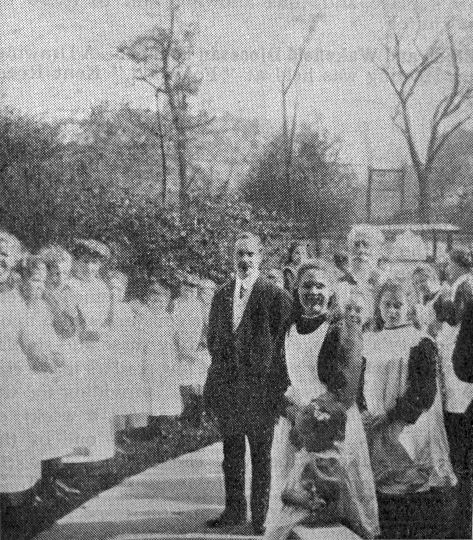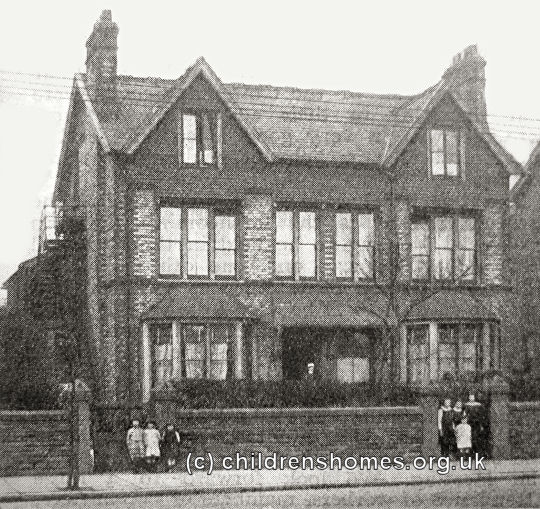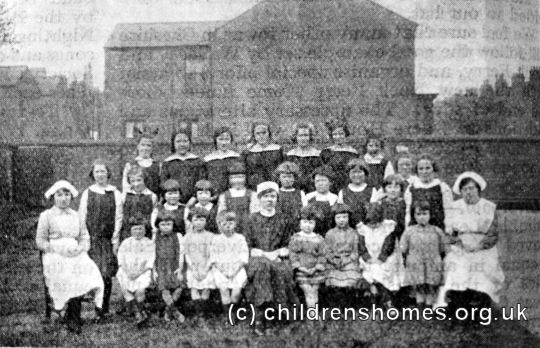Greenheys Orphanage / Galloway Home For Girls, Whalley Range, Lancashire
The Greenheys Orphanage and Training Institution for Girls was established in the 1870s at Greenhill Street, Greenheys, Manchester, with its aim being 'the rescue of orphan girls from a state of poverty and their maintenance until they are of an age to earn.' The girls were taught sewing and domestic work with most eventually employed as domestic servants.
On December 1st, 1883, new premises for the establishment, at 34 Upper Chorlton Road, Whalley Range, were opened by the Mayor of Manchester, Mr Philip Goldschmidt. The cost of the property had been paid for by Manchester industrialist John Galloway, whose wife, Mary, who had been a moving force in founding the institution. The new home was said to be 'a cheerful, well-lighted, commodious building' with a playground and lawn.
In 1910, the home was taken over by the Waifs and Strays Society. At its official dedication on May 6th, 1911, the home was renamed the Galloway Home for Girls in recognition of the many years of support it had received from Mary Galloway. The new building could accommodate 20 girls aged from 6 to 13.

Opening of Galloway Home For Girls, Whalley Range, c.1911. © Peter Higginbotham

Galloway Home For Girls, Whalley Range, c.1925. © Peter Higginbotham

Galloway Home For Girls, Whalley Range, c.1925. © Peter Higginbotham
Children at the Society's homes usually had a summer holiday, sometimes doing an exchange visit with children at another home. A regular destination for the Galloway Home girls was St Annes on Sea, near Blackpool.

Girls from Galloway Home on holiday at St Annes on Sea, 1924. © Peter Higginbotham

Galloway Home For Girls, Whalley Range, c.1929. © Peter Higginbotham

Galloway Home For Girls, Whalley Range, c.1931. © Peter Higginbotham
The home closed following the outbreak of the Second World War in 1939. the girls were initially evacuated to Bowdon, near Altrincham. The following year, after Bowdon had been judged to lack adequate air-raid defences, the girls briefly returned to Whalley Range. They were then transferred to the Ashleigh Home near Bolton and again, in 1947, to the Victoria Home at Formby, near Liverpool.
The Whalley Range building no longer survives and modern flats now occupy the site.
Records
Note: many repositories impose a closure period of up to 100 years for records identifying individuals. Before travelling a long distance, always check that the records you want to consult will be available.
- Index of the Society's first 30,000 children's case files ordered by surname.
- Index of the Society's first 30,000 children's case files ordered by date of birth.
- The Children's Society Records and Archive Centre is at Unit 25, Springfield House, 5 Tyssen Street, London E8 2LZ (email: archives@childrenssociety.org.uk). Files for children admitted to its homes after September 1926 were microfilmed in the 1980s and the originals destroyed. Some post-1926 files had already been damaged or destroyed during a flood. The Society's Post-Adoption and Care Service provides access to records, information, advice, birth record counselling, tracing and intermediary service for people who were in care or adopted through the Society.
- The Society has produced detailed catalogues of its records relating to disabled children, and of records relating to the Children's Union (a fundraising body mostly supported from the contributions of children).
Bibliography
- Bowder, Bill Children First: a photo-history of England's children in need (1980, Mowbray)
- Church of England Waifs and Strays' Society [Rudolfe, Edward de Montjoie] The First Forty Years: a chronicle of the Church of England Waifs and Strays' Society 1881-1920 (1922, Church of England Waifs and Strays' Society / S.P.C.K.)
- Higginbotham, Peter Children's Homes: A History of Institutional Care for Britain's Young (2017, Pen & Sword)
- Morris, Lester The Violets Are Mine: Tales of an Unwanted Orphan (2011, Xlibris Corporation) — memoir of a boy growing up in several of the Society's homes (Princes Risborough, Ashdon, Hunstanton, Leicester) in the 1940s and 50s.
- Rudolf, Mildred de Montjoie Everybody's Children: the story of the Church of England Children's Society 1921-1948 (1950, OUP)
- Stroud, John Thirteen Penny Stamps: the story of the Church of England Children's Society (Waifs and Strays) from 1881 to the 1970s (1971, Hodder and Stoughton)
Links
- Hidden Lives Revealed — the story of the children who were in the care of The Children's Society in late Victorian and early 20th Century Britain.
- The Children's Society
Except where indicated, this page () © Peter Higginbotham. Contents may not be reproduced without permission.


